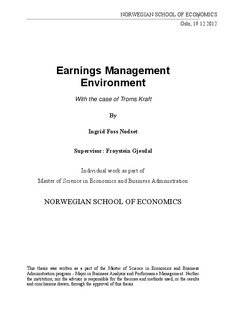Earnings management environment : with the case of Troms Kraft
Master thesis
Permanent lenke
http://hdl.handle.net/11250/170026Utgivelsesdato
2012Metadata
Vis full innførselSamlinger
- Master Thesis [4372]
Sammendrag
In this paper I examine the topic of earnings management and use a case example. In the first part of the paper I review theory on two closely related topics - earnings management and fraud - and present and discuss incentives, methods, typical indications and frequency of earnings management in the financial statements. I continue to describe the frameworks and laws that apply to revenue recognition and how income is recognized in the power industry, as this is especially relevant for the case. Further, I describe the auditor’s and the board of director’s responsibilities to detect fraud according to the law.
The next part deals with one of the largest Nordic accounting scandals in recent years. In 2011 it was discovered that a subsidiary of Troms Kraft had recorded fictitious revenues of 1.5 billion over a period of 10 years. I examine the company’s financial statements in the years before the fraud was uncovered to evaluate if there are any indications of misstatements. Moreover, I analyze the company’s environment to identify factors that increased the risk of fraud, including motivations and opportunities of fraud. The aim of the analysis is to investigate how the company was able to record the fictitious revenues, by drawing upon established academic literature on earnings management and fraud.
In the last part I will analyze which control mechanisms the company had in place, mainly focusing on the composition and quality of the board of directors and the auditor. This way I try to answer whether they performed their duties to prevent and discover fraud. By both considering the company’s specific risks and indications of earnings management, I will conclude on whether the control mechanisms were adequate and should have detected the fraud at an earlier point.
